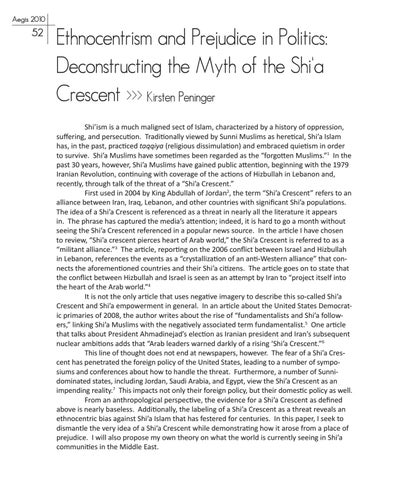Aegis 2010
52
Ethnocentrism and Prejudice in Politics: Deconstructing the Myth of the Shi’a Crescent >>> Kirsten Peninger Shi’ism is a much maligned sect of Islam, characterized by a history of oppression, suffering, and persecution. Traditionally viewed by Sunni Muslims as heretical, Shi’a Islam has, in the past, practiced taqqiya (religious dissimulation) and embraced quietism in order to survive. Shi’a Muslims have sometimes been regarded as the “forgotten Muslims.”1 In the past 30 years, however, Shi’a Muslims have gained public attention, beginning with the 1979 Iranian Revolution, continuing with coverage of the actions of Hizbullah in Lebanon and, recently, through talk of the threat of a “Shi’a Crescent.” First used in 2004 by King Abdullah of Jordan2, the term “Shi’a Crescent” refers to an alliance between Iran, Iraq, Lebanon, and other countries with significant Shi’a populations. The idea of a Shi’a Crescent is referenced as a threat in nearly all the literature it appears in. The phrase has captured the media’s attention; indeed, it is hard to go a month without seeing the Shi’a Crescent referenced in a popular news source. In the article I have chosen to review, “Shi’a crescent pierces heart of Arab world,” the Shi’a Crescent is referred to as a “militant alliance.”3 The article, reporting on the 2006 conflict between Israel and Hizbullah in Lebanon, references the events as a “crystallization of an anti-Western alliance” that connects the aforementioned countries and their Shi’a citizens. The article goes on to state that the conflict between Hizbullah and Israel is seen as an attempt by Iran to “project itself into the heart of the Arab world.”4 It is not the only article that uses negative imagery to describe this so-called Shi’a Crescent and Shi’a empowerment in general. In an article about the United States Democratic primaries of 2008, the author writes about the rise of “fundamentalists and Shi’a followers,” linking Shi’a Muslims with the negatively associated term fundamentalist.5 One article that talks about President Ahmadinejad’s election as Iranian president and Iran’s subsequent nuclear ambitions adds that “Arab leaders warned darkly of a rising ‘Shi’a Crescent.”6 This line of thought does not end at newspapers, however. The fear of a Shi’a Crescent has penetrated the foreign policy of the United States, leading to a number of symposiums and conferences about how to handle the threat. Furthermore, a number of Sunnidominated states, including Jordan, Saudi Arabia, and Egypt, view the Shi’a Crescent as an impending reality.7 This impacts not only their foreign policy, but their domestic policy as well. From an anthropological perspective, the evidence for a Shi’a Crescent as defined above is nearly baseless. Additionally, the labeling of a Shi’a Crescent as a threat reveals an ethnocentric bias against Shi’a Islam that has festered for centuries. In this paper, I seek to dismantle the very idea of a Shi’a Crescent while demonstrating how it arose from a place of prejudice. I will also propose my own theory on what the world is currently seeing in Shi’a communities in the Middle East.



